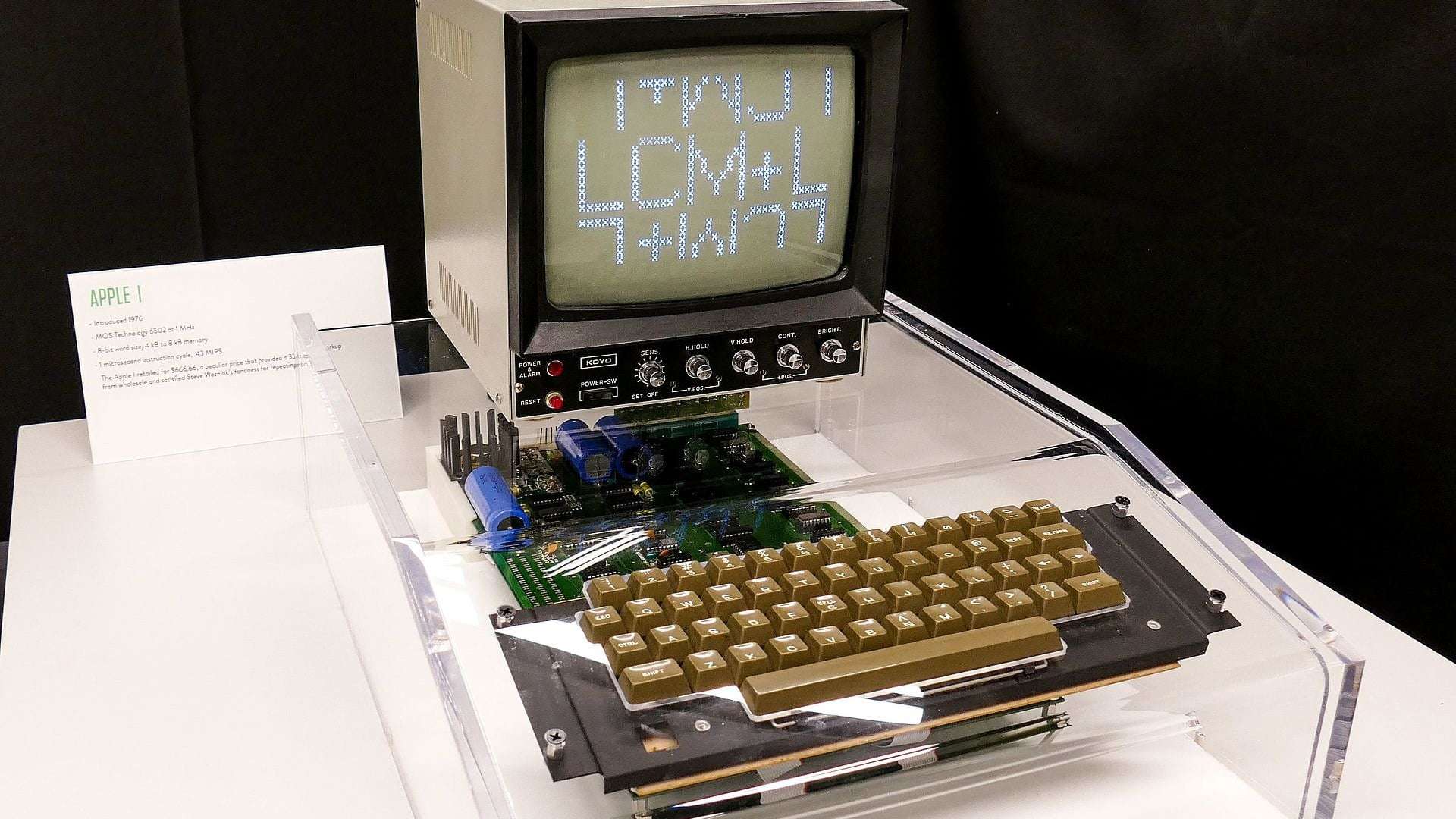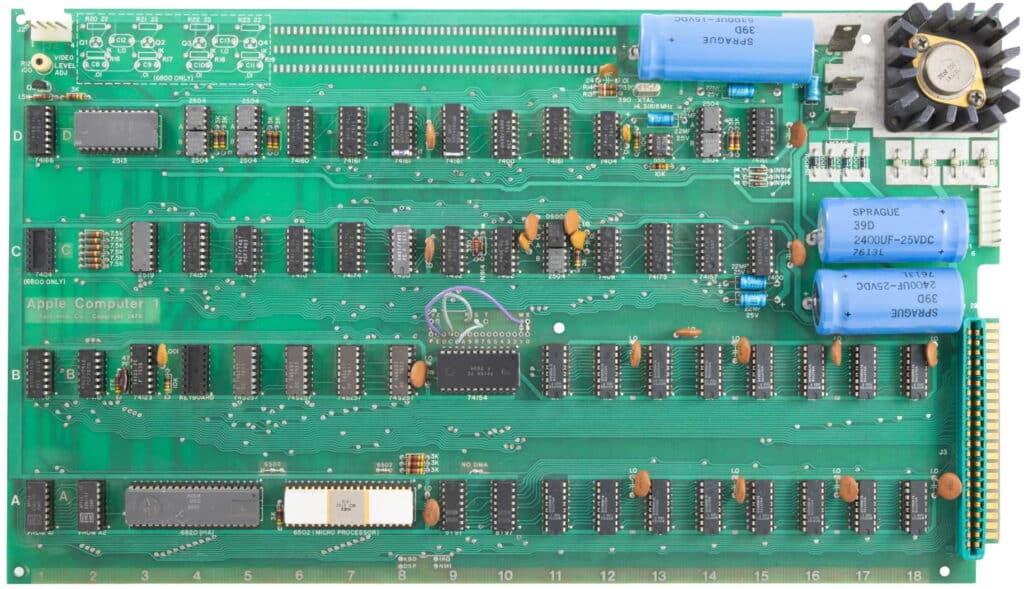
Just a heads up, if you buy something through our links, we may get a small share of the sale. It’s one of the ways we keep the lights on here. Click here for more.
The iconic Apple 1 wasn’t a commercial success. It showed none of the engineering refinement that defines Cupertino’s present output. But it was — and is — a hugely important machine.
Within the annals of computing history, it represents the starting pistol in the race to move computers from the business world to the home.
Released in 1976 and produced in microscopic numbers, it predates the modern internet by a long stretch.
It’s fifteen years older than HTTP — the protocol defining how web browsers and servers interact. And roughly seventeen years older than Mosaic, the first real visual web browser.
You’d instinctively think the internet is a rubicon too far for the Apple 1. But it isn’t, as Philadelphia-based retrocomputing enthusiast Sean Malseed showed.
How to find an Apple 1 without breaking the bank
Malseed is a high-profile figure in the retrocomputing world. His ActionRetro channel provides slick explanations of long-forgotten computers.
These typically involve digging into the machine’s innards, where he forensically explores the design dilemmas and technical limitations faced by prehistoric consumer technology companies.
And no, he’s not obscenely wealthy. At least, I don’t think he is. Original Apple 1 computers — those built with Woz’s Midas touch and packaged by Jobs’ own hands — cost a fortune. I mean that literally, not figuratively.
Last year, John Moran Auctioneers in California sold a working model for $400,000. When you include the auctioneer’s premium and other fees, the actual figure reaches a cool $500,000.
Malseed may be a successful YouTuber in his own right, but I doubt his ad revenue earnings stretch that far.

The Apple 1’s circuitry isn’t that sophisticated. Nor was it technologically unique for the time. Woz and Jobs worked with a shoestring budget and used common off-the-shelf components to build Apple’s first machines.
Many of those components remain in production to this day. Others can be found lurking in dusty closets. In retrocomputing parlance, these are known as “new old stock.” Malseed’s reproduction used a combination of both.
Connecting the Apple 1 to the modern internet

Okay, so now you want to hear about how Malseed connected the Apple 1 to the internet. This is where things get interesting.
The original Apple 1 predates the standardization (let alone the widespread commercial availability of Ethernet). An eternity spans between its first early release and the introduction of Wi-Fi.
Here’s the thing: The Apple 1 is a source of curiosity among retro tech geeks. A thriving community surrounds the vintage machine, which routinely manufactures modern expansion cards that dramatically expand its capabilities.
Apple originally intended for people to use the expansion slot to add an external cassette drive. In 1976 (and even until the late 1980s), tapes were the primary medium for sharing files and programs.
Floppy disks and hard drives existed, sure, but they were eye-wateringly expensive. They cost far beyond what an ordinary computer enthusiast could afford.

By contrast, cassettes were ubiquitous. They were cheap. Admittedly, this came at the cost of transfer speeds and the potential for data corruption should the cassette stray within reach of a powerful-enough magnet.
Most hobbyists tolerated this simply due to a lack of a viable alternative. But the Apple 1’s expansion slot proved wildly versatile.
Think about it. When you connect a tape reader (or any data storage device, like a CD-RW burner or a USB thumb drive), your computer is simply reading and writing bits to a destination.
Malseed used a third-party card that acts as a ‘bridge’ between his Wi-Fi network and the Apple 1.
The expansion card — the Apple-1 Wi-Fi Moden — did the hard work of connecting to a wireless network, sending and receiving requests, and converting online content into a format that the vintage computer could use.
The interaction between the Apple 1 and the Wi-Fi modem used the same basic computer operations as with a tape reader.
It would write data (in the form of addresses or menu interactions) and read data (in the form of web content). Same principles, but just applied differently.
Browsing like it’s 1976
In many respects, the Apple 1 acted almost like a ‘dumb terminal,’ presenting data but not really interacting with it in any meaningful sense. That’s pretty much expected for a computer of its vintage.
This leads us to our last question: What is the internet like on a 1976-era computer? Well, it’s as you’d expect. It’s fundamentally text-based.
Malseed primarily showed the machine interacting with period-appropriate BBS (bulletin board system) forums and playing an online game of Zork (which came out one year after the Apple1, albeit for the PDP-10 mainframe computer).
It’s unlikely we’ll ever see this feat replicated on an original Apple 1. These are museum pieces. They cost more than the median household earns in eight years. They belong behind a thick-cut sheet of plexiglass.
The closest we’ll ever get is someone modifying a replica, as with Malseed. And rightfully so.
Is it a practical way of using the internet in 2022? Hell no. But damned if it isn’t the coolest thing I’ve seen this month.
Have any thoughts on this? Carry the discussion over to our Twitter or Facebook.
Editors’ Recommendations:
- Apple VR headset: Release date, features, and price
- Apple finally expands self-repair program to cover MacBooks, but it’s not perfect
- Apple AirPods Pro 2 have better noise canceling and battery life
- iPhone 14 has no mini, but you can still get last year’s for cheap





























